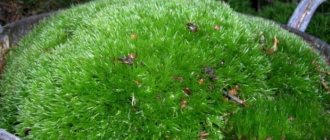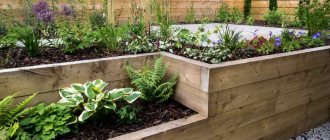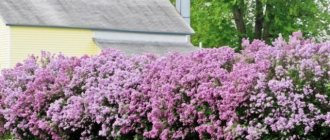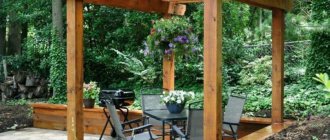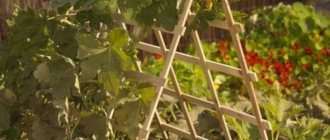Features and Benefits
In the photos presented, trellises are shown as vertical structures in the form of flat latticework, however, products prepared for greenhouses can be ordinary racks with crossbars. A trellis for raspberries or blackberries can look just as simple.
Tall structures with a large area are very convenient to use. They successfully play the role of partitions in the design zoning of the site. The advantages of using trellises include the following:
- free distribution of branches in space, facilitating sufficient light;
- stimulating the metabolism of fruiting crops and accelerating ripening;
- active ventilation of plants, preventing the development of various diseases;
- ease of care and handling.
With the help of lattice structures, you can build a hedge or decorate the wall of any building with a green carpet.
Subtleties of growing blackberries
Not only tomatoes, cucumbers or raspberries, but also blackberries can be successfully grown on a trellis. The blackberry option involves the use of tall varieties. Without constant and reliable support, they are unlikely to be able to grow. But varieties that have many branches are absolutely not suitable for you. They do not wrap around the trellis well, so they will appear unkempt. When growing, seedlings must be placed at a distance of at least 1 meter.
By the time of tying, each individual bush must have at least four full branches. They are placed in a shape somewhat reminiscent of a fan. Then each shoot is tied to the crossbar below. The central branches are shortened more than the lateral ones. This will allow them to grow on par with their neighbors and not lag behind.
Each branch that shortens should produce shoots. We always carry out basic pruning in the spring. It is at this time of year that the buds begin to actively grow and bloom, forming new shoots. Climbing blackberries on a trellis look great, especially when the berries are ripening. To make maintenance even easier, you can do the following:
- Before planting bushes, place trellises on a personal plot 2 meters long.
- Pull 4 wires. One of them will be at a distance of 50 cm from the ground, the rest - 40 cm.
- Plant the seedlings at a distance of two meters.
- Trim the ground part to twenty centimeters.
When the first shoots begin to appear, leave not all of them, but only the strong ones. According to their height, they are tied to each wire, with the exception of the top one. New branches that begin to appear are brought to the top wire. Branches that already bore fruit last year are cut off. The rest are distributed along the wire below. The top wire becomes free again.
Blackberries on trellises
You can repeat this care every year - the blackberries will begin to bear fruit 2-3 times better. It is better not to tie up varieties that do not tolerate wintering well at all, but to leave them on the ground.
Plants will look better and get sick less often if you do timely pruning and staking, and also plant each bush correctly. This is further proof of how trellises can help support plantings and ensure proper formation of shoots.
The positive effect of using a trellis applies not only to blackberries and grapes, but also to many vegetable plants, as well as raspberries.
Types of trellises
All garden structures can be divided into types according to shapes and materials. Forms are selected in accordance with the location on the site, climatic conditions and plant type.
The choice of materials is based on the tastes and preferences of the owner of the site and the design features of the landscape design.
Non-standard option
If you don’t want to waste time, there is a trellis option, the implementation of which will take only half an hour.
Planting and caring for thuja occidentalis - detailed instructions with tips for properly growing thuja (photos and videos)- Do-it-yourself vertical flowerbed - learn how to make a beautiful and original flowerbed yourself (photos and videos)
Unpretentious flowers for the garden - a review of the best types and ways of combining flowers for a beautiful garden design! (Photo and video)
Do-it-yourself trellis is quite doable. The main thing in its manufacture is accuracy, patience, and quality materials. If you have all this, then you can safely start creating it.Here three pegs are used (they act as supports) and a ready-made coarse mesh. The pegs are driven into the ground and a net is attached to them. The design turns out to be quite interesting and unusual.
Classification of forms
The most popular types of models include:
- a vertical single-plane structure that performs the functions of a partition, fence, wall decoration;
- two-plane trellis, consisting of gratings connected at the top; from such models you can create arches or tunnels - for example, trellises for roses can be used as arches, and a tunnel structure will be good as a trellis for grapes;
- horizontal model (quite rare);
- corner design, ideal for zoning.
It is better to place trellises on flat, open areas near recreation areas or dining areas. Wall structures can be supplemented with vertical or container flower beds.
Building a metal pergola
The peculiarity of using metal as a building material is that it is more reliable and requires less maintenance. The metal is immediately primed and then painted. With a good coating of good paint, this will last for several years.
Wood is more of a hassle. In our climate, we have to renew the coating every year. Therefore, it is better not to use varnishes: they crack, turn white, and come off in parts. To renew the coating, you need to clean everything off and then recoat it. Therefore, it is better not to use even the best varnishes for outdoor garden or outbuildings. To treat wood that is outdoors all year round, there are oils to which color is added. They do not provide shine, but perfectly protect the surface from climatic influences. The worst thing that can happen is that it will fade a little. To re-treat the surface, it must be cleaned of dirt and dried. Can be painted. Touch drying usually takes a couple of hours. Convenient, beautiful, reliable.
The difference between metal is also in the assembly method. This is either welding or bolted assembly. Everyone chooses the method themselves. Due to the fact that the corrosion resistance of painted metal is quite high, it can simply be concreted. Therefore, there are fewer difficulties with installing pillars. It is only more difficult to work with it because of its mass. But everywhere has its drawbacks.
And the variety of metal pergolas is, perhaps, even greater than wooden ones: they can be forged and bent into bent shapes. Metal is combined with stone, brick, wood. An awning is pulled over a metal frame, wicker mats are laid, and roller blinds are secured. See examples in the photo gallery (it opens to full faucet if you need it).
Under this carpet the pergola itself is not visible. It is built like a gazebo: the frame is welded from pipes, everything else is plants
How to join metal and wood
Rolls of mats are fixed on a metal pergola
Another arch for roses is the garden pergola that we see most often
This is the pergola that we call “arch for flowers or grapes”
Another example of using an awning. The main highlight is in contrast
Another combination of wood and metal, but the design is different, the feeling is different
Forging elements are always relevant. Plants that grow over time will turn this pergola into the most comfortable place
Combination of metal and polycarbonate. Both materials allow for curved shapes
Light pergola over the entrance - an awning is stretched over a metal frame
Clear geometric lines, powerful columns, simple and stylish
Racks and main beams made of metal, auxiliary beams made of wood
Variety of materials
Since the trellis is usually located outside, decorating the area, supporting the impressive weight of plants and being exposed to many external factors, the main requirements for its design are a presentable appearance, strength and stability. Therefore, the best options for materials for making trellises include:
- wooden block with slats;
- metal rod and pipe;
- plastic tube and all kinds of mesh fabric.
Wood is considered the most popular and frequently used material. It weighs a little, although it has sufficient strength, is environmentally friendly, easy to process and looks aesthetically pleasing. Therefore, for making your own, a wooden trellis is best suited.
Garter peas
Gardeners have been tying up legumes for a long time . After all, harvesting from vines spreading along the ground is very problematic. And half of the pods, especially during the rainy season, will simply rot. Plus, due to insufficient lighting, peas lose their taste and sweetness, since they are not able to accumulate sufficient nutrients.
On an inclined trellis, pods hanging vertically will be more visible
There is no need to build structures that are too complex for peas. Any available materials will do, including branches of thick trees. They are sharpened at one end, driven into the ground and tied together with wire.
We will not describe detailed step-by-step instructions for making pea trellises. In the photo below, you can choose the type of trellis for legumes that suits you.
Trellis for peas
Making a trellis with your own hands
Before starting self-assembly, you should decide on the location and draw drawings of the trellis, which will help you correctly calculate the amount of material needed.
If you plan to build a large, solid structure, you will need to purchase or cut out bars and slats yourself according to the indicated dimensions in the required quantity.
For greenhouse or small garden beds, you can use scraps of lumber, which are always present in abundance at the dacha.
How to make a trellis from wooden parts yourself, step-by-step instructions will help:
- At the initial stage, you need to prepare hand and power tools, fasteners and materials. The material will be two long and two short bars for constructing the lattice frame.
- You need to make small cuts at the ends of the bars and remove excess wood to create grooves. Using grooves, the frame is connected and secured with glue and self-tapping screws.
- Next, the slats are attached to the frame. One part is placed at a slope in one direction, the other in the opposite direction. If they are placed at right angles, they will form windows in the form of squares. If you make the corners sharp, you get diamonds.
- After completing work on the grille, the structure will need to be securely installed. Since the trellis is not a monumental structure, but rather mobile, its installation does not require the construction of a solid foundation. The grille can be mounted on thick fittings, a pipe or a block pre-treated from moisture. The main thing is to dig in the supports so that the structure does not sway under the influence of wind or touch. If desired, the trellis can be easily dismantled and moved to another location.
An original garden product can be assembled from any available material. For example, if you have the skills of a welder, you can build an elegant metal product from reinforcement bars and decorate it with ready-made or self-made forged elements.
A stylish trellis, created by yourself, can become a real decoration of landscape design.
Tomato garter
Varieties for open ground are often simply tied to stakes made of wood, plastic or reinforcement. The length of the stakes should exceed by 27-30 cm the average length of a mature adult plant.
The stakes, pointed on one side, are driven almost end-to-end, at a distance of several centimeters from the bush. Tomatoes are tied to such a stake with a rope using the figure-of-eight method, that is, twisting each bush twice.
Garter of tall tomatoes
But this method is only suitable for medium-sized tomatoes - powerful plants on tall stems can simply fall along with the stakes. Yes, and quickly growing plants will have to be tied up several times a season.
Tall greenhouse tomatoes are best secured to strong supports.
To create trellises you will need:
Another way to attach bushes is linear garter . In this case, between the supports driven into the ground, a horizontal upper crossbar is attached, to which a rope is tied, the lower end of which is attached to the bush. You shouldn't tighten it too much. As the plant grows, this twine will gradually twine around new shoots.
Linear garter of tomatoes
Choosing plants for a “green room”
To prevent the structure from being transparent inside the “green room,” we planted several young actinidia bushes; over time, their vines form walls, and a little later, a roof for the summer kitchen, moving towards the country house, for which an additional wire was stretched from the trellis to the roof of the house .
In our opinion, Actinidia Kolomikta is the best vine capable of coping with the task assigned to it. This amazing plant is not only incredibly beautiful (male specimens develop very original white and pinkish spots at the ends of the leaf blade), but also unpretentious (virtually no care required, tolerates low winter temperatures below -30 degrees without shelter), and bears delicious aromatic fruits - miniature copies of overseas kiwi.
Maiden grapes and actinidia create green walls.
In addition, the location was not too sunny, and actinidia feels good in partial shade. Since actinidia is a dioecious plant, two female and one male specimens were planted to cover the six square meter structure.
Over time, numerous shoots with large, whole leaves will completely cover the trellis, leaving not the slightest gap. But the nature of most vines is such that in the first three years, young seedlings build up the root system, and the above-ground part grows very slowly.
While our actinidia were still very tiny, in the first years the functions of “green walls” were performed by annual fast-growing bindweeds (morning glory, ornamental beans and others). The first year, annual dolichos (hyacinth beans) successfully fulfilled this role, and subsequently varietal vines were planted with the annual vines, which grow somewhat faster than actinidia and, in addition, provide the structure with a very elegant look in the autumn thanks to brightly colored foliage.
Maiden grapes and actinidia form a bright yellow-red combination in autumn.
